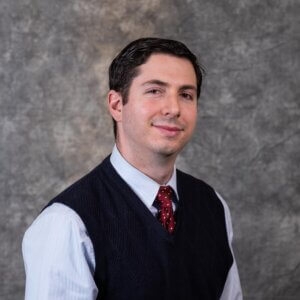
The Pomeroy Foundation welcomes a new team member to the Legends & Lore program to help tell the stories of regional folklore and legends beyond the marker inscriptions.
David J. Puglia, Ph.D., will bring his expertise to the program as a Folklore Writer, creating descriptions for Legends & Lore markers on the Foundation’s digital map. The map has become a popular, go-to source of information that expands upon original marker inscriptions and conveys a more robust summary about each respective folklore or legend.
A scholar, folklorist and author, David is Associate Professor and Deputy Chairperson in the English Department at Bronx Community College of The City University of New York. In this Q&A, David talks about his passion for legends, the importance of engaging the public, and what he’s looking forward to about his role with Legends & Lore.
What appealed to you about the Legends & Lore program?
While folklorists are interested in the public by definition, the research and writing process itself can often be very solitary and isolating. The Legends & Lore program is an ideal way to connect my intellectual interests with real people and communities. I often work on very long pieces of writing with lengthy turnaround times and restricted audiences in hardback books and academic journals. The possibility of writing shorter pieces with quicker turnaround times that are easily accessible and freely available to the public appealed to me.
What are you looking forward to about being a Legends & Lore Folklore Writer?
I’ve been deeply enmeshed in the legendry of the Northeast for over a decade now, especially Maryland, Pennsylvania, New Jersey, and New York. I’m looking forward to learning about local legends beyond my East Coast radius, especially ones I’ve never heard of before in any form.
What legends or folklore are you most interested in?
I began my career studying legends of regional monsters and cryptids. Bigfoot, the Chupacabra, and the Jersey Devil are the American celebrity monsters, though I started with a humbler Maryland monster known as the Goatman. I’m also interested in local legendry, and to that end, I’ve done two books on state and regional legends: Maryland Legends and South Central Pennsylvania Legends & Lore. In local legendry, I love legends that follow what I call the “Horton Effect,” that is local legendry that seeks to explain the importance of overlooked and underrepresented places.
What’s one “fun fact” related to your interest in folklore?
I love folklore so much I even married a folklorist. I met my wife at a folklore conference in Bloomington, Indiana. We then had our honeymoon at a legend conference in Prague.
How do you see Legends & Lore markers benefiting communities?
Legend can promote local pride, teach local heritage, and support local business. Pride comes from carrying on a tradition and promoting the notoriety of a place, whether it’s of a notable person, an important invention, or even a unique being or occurrence. Heritage considerations come from how legend connects the present to the past and to other historical events. And in some locations, the interest surrounding a legend can even spur tourism and boost a place financially.
What do you like most about the interactive, digital marker map?
For me, looking at the Legends & Lore digital marker map is a new and exciting way to view the United States and appreciate local legends, local heritage, and local pride. It’s also great for tourists, daytrippers, legend trippers, staycationers, history buffs, and culture lovers who want to dive a little deeper into a locality in a unique fashion.
What state should Lore & Legends come to next (pending a partner) and why?
Being born and raised in Maryland and having written a book on Maryland legends, I have an obvious bias towards the Old Line State. Maryland is as diverse in legendry as it is in environment. It’s got the Goatman, the Dwayyo, Chessie, Barbara Fritchie, Black Aggie, Hell House, the Poe Toaster, the Demon Car of Seven Hill Road, and plenty more. The Free State would be an excellent candidate for Legend & Lore’s next foray.
What subjects do you hope to see more of in the Legends & Lore program?
I don’t have a preference for the subject so much as for the local investment in the legend. Whether it’s a ghost legend or an invention legend, a monster legend or a historical legend, it’s the community’s commitment to narrating, passing on, and preserving the lore that creates the “magic” of a good legend.
